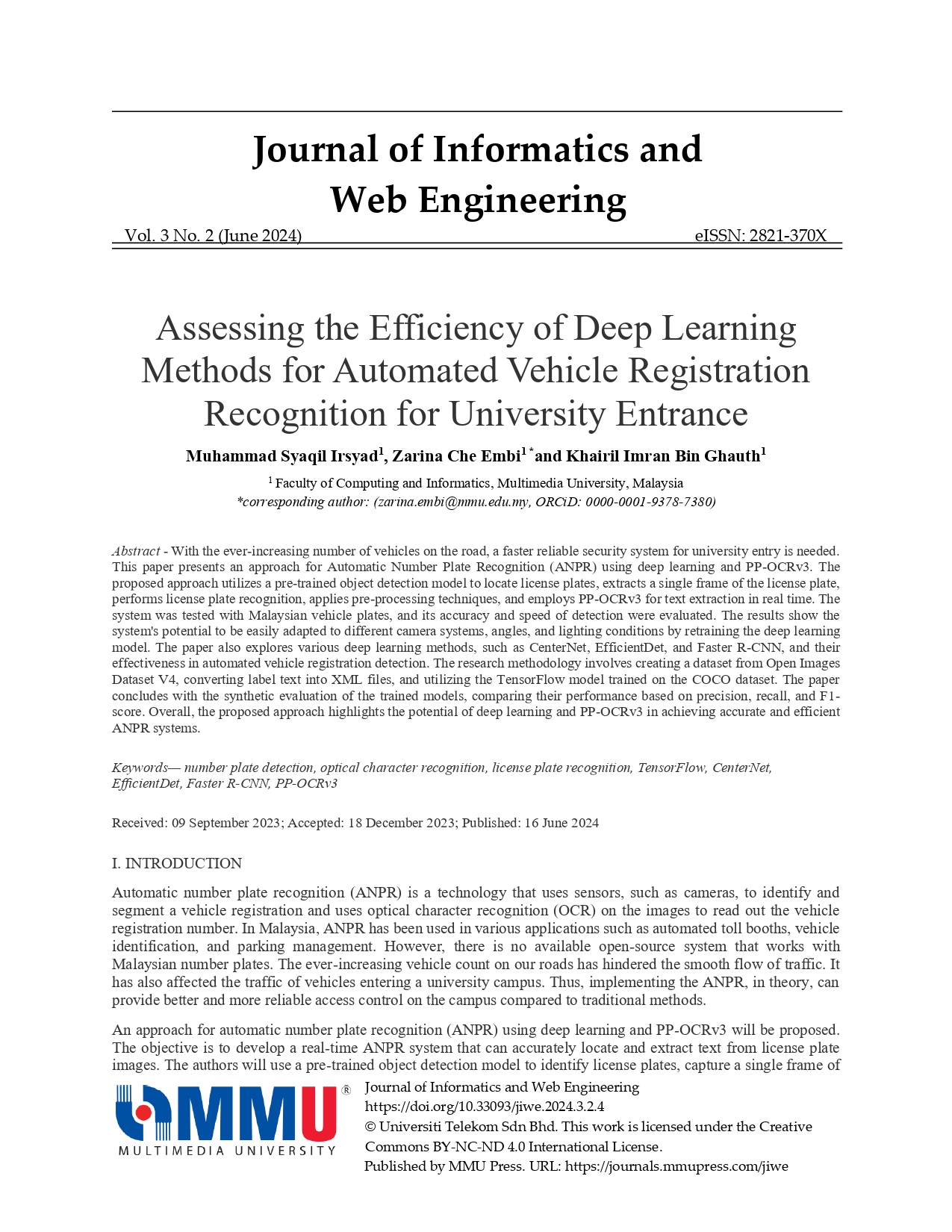Assessing the Efficiency of Deep Learning Methods for Automated Vehicle Registration Recognition for University Entrance
Main Article Content
Abstract
With the ever-increasing number of vehicles on the road, a faster reliable security system for university entry is needed. This paper presents an approach for Automatic Number Plate Recognition (ANPR) using deep learning and PP-OCRv3. The proposed approach utilizes a pre-trained object detection model to locate license plates, extracts a single frame of the license plate, performs license plate recognition, applies pre-processing techniques, and employs PP-OCRv3 for text extraction in real time. The system was tested with Malaysian vehicle plates, and its accuracy and speed of detection were evaluated. The results show the system's potential to be easily adapted to different camera systems, angles, and lighting conditions by retraining the deep learning model. The paper also explores various deep learning methods, such as CenterNet, EfficientDet, and Faster R-CNN, and their effectiveness in automated vehicle registration detection. The research methodology involves creating a dataset from Open Images Dataset V4, converting label text into XML files, and utilizing the TensorFlow model trained on the COCO dataset. The paper concludes with the synthetic evaluation of the trained models, comparing their performance based on precision, recall, and F1-score. Overall, the proposed approach highlights the potential of deep learning and PP-OCRv3 in achieving accurate and efficient ANPR systems.
Article Details

This work is licensed under a Creative Commons Attribution-NonCommercial-NoDerivatives 4.0 International License.
All articles published in JIWE are licensed under a Creative Commons Attribution-NonCommercial-NoDerivatives 4.0 International (CC BY-NC-ND 4.0) License. Readers are allowed to
- Share — copy and redistribute the material in any medium or format under the following conditions:
- Attribution — You must give appropriate credit, provide a link to the license, and indicate if changes were made. You may do so in any reasonable manner, but not in any way that suggests the licensor endorses you or your use;
- NonCommercial — You may not use the material for commercial purposes;
- NoDerivatives — If you remix, transform, or build upon the material, you may not distribute the modified material.
References
A. Ammar, A. Koubaa, W. Boulila, B. Benjdira, & Y. Alhabashi (2023). A Multi-Stage Deep-Learning-Based Vehicle and License Plate Recognition System with Real-Time Edge Inference. Sensors (Basel, Switzerland), 23(4), 2120. https://doi.org/10.3390/s23042120
EscVM. (2019). GitHub - EscVM/OIDv4_ToolKit: Download and visualize single or multiple classes from the huge Open Images v4 dataset. GitHub. https://github.com/EscVM/OIDv4_ToolKit
R. Fernandes, K.M. Rai, A.P. Rodrigues, B.A. Mohan, N. Sreenivasa & N. Megha (2021). Recognition of Moving Vehicle Number Plates using Convolutional Neural Network and Support Vector Machine Techniques. In 2021 IEEE International Conference on Distributed Computing, VLSI, Electrical Circuits and Robotics (DISCOVER), pp. 93-98, IEEE.
P.T. Gayathri, A. Bhavana, M. Anuhya, M. Kavitha, N.K. Chakravarthy & D.M. Reddy (2022). Moving Vehicle Number Plate Detection using Hybrid Deep Convolutional and Recurrent Neural Network Algorithm. In 2022 IEEE 2nd International Conference on Sustainable Energy and Future Electric Transportation (SeFeT), pp. 1-5, IEEE.
Z. Guo, W. Yi, Y. Wu & T. Luo (2021). Robust radar detection and classification of traffic vehicles based on anchor-free CenterNet. In 2021 International Conference on UK-China Emerging Technologies (UCET), pp. 252-257, IEEE.
O. Hmidani & E.I. Alaoui (2022). A comprehensive survey of the R-CNN family for object detection. In 2022 5th International Conference on Advanced Communication Technologies and Networking (CommNet), pp. 1-6, IEEE.
J. J. Ng, K. O. M. Goh, and C. Tee, “Traffic Impact Assessment System using Yolov5 and ByteTrack,” J. Informatics Web Eng., vol. 2, no. 2, pp. 168–188, Sep. 2023, doi: 10.33093/jiwe.2023.2.2.13.
V. Kamath & A. Renuka (2021). Performance Analysis of the Pretrained EfficientDet for Real-time Object Detection on Raspberry Pi. In 2021 International Conference on Circuits, Controls and Communications (CCUBE), pp. 1-6, IEEE.
C. Li, W. Liu, R. Guo, X. Yin, K. Jiang, Y. Du, Y. Du, L. Zhu, B. Lai, X. Hu, D. Yu, Y. Ma (2022). PP-OCRv3: More Attempts for the Improvement of Ultra Lightweight OCR System. arXiv (Cornell University). https://doi.org/10.48550/arxiv.2206.03001
M. Li, H. Ge & H. Wang (2022). IMG-centernet: an optimized algorithm based on CenterNet for pedestrian detection. In 2022 IEEE 6th Information Technology and Mechatronics Engineering Conference (ITOEC), Vol. 6, pp. 203-208, IEEE.
Y. Li, S. Zhang & W.Q. Wang (2020). A lightweight faster R-CNN for ship detection in SAR images. IEEE Geoscience and Remote Sensing Letters, 19, pp. 1-5.
Open Images V7 – Description. (2023, May 15). Retrieved from Open Images V7 - Description (storage.googleapis.com)
T.A. Pham (2023). Effective deep neural networks for license plate detection and recognition, Visual Computer, 39(3), pp. 927-941.
M. Tan, R. Pang & Q.V. Le (2020). Efficientdet: Scalable and efficient object detection. In Proceedings of the IEEE/CVF conference on computer vision and pattern recognition, pp. 10781-10790.
Tensorflow. (2021, May 7). models/research/object_detection/g3doc/tf2_detection_zoo.md at master · tensorflow/models. GitHub. https://github.com/tensorflow/models/blob/master/research/object_detection/g3doc/tf2_detection_zoo.md
TFRecord and tf.train Example, TensorFlow. (2023, May 15). Retrieved from https://www.tensorflow.org/tutorials/load_data/tfrecord
T. A. Khan, R. Sadiq, Z. Shahid, M.M. Alam, & M. B. M. Su'ud, “Sentiment Analysis using Support Vector Machine and Random Forest,” J. Informatics Web Eng., vol. 3, no. 1, pp. 67–75, Feb. 2024, doi: 10.33093/jiwe.2024.3.1.5.

